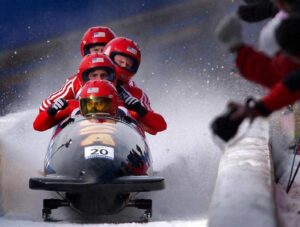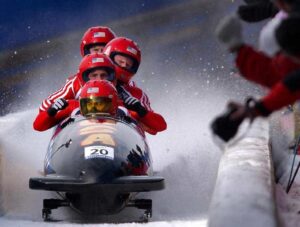The metal-based daguerreotype process soon had some competition from the paper-based calotype negative and salt print processes invented by William Henry Fox Talbot. Subsequent innovations reduced the required camera exposure time from minutes to seconds and eventually to a small fraction of a second; introduced new photographic media which were more economical, sensitive or convenient, including roll films for casual use by amateurs; and made it possible to take pictures in natural color as well as in black-and-white.
The commercial introduction of computer-based electronic digital cameras in the 1990s soon revolutionized photography. During the first decade of the 21st century, traditional film-based photochemical methods were increasingly marginalized as the practical advantages of the new technology became widely appreciated and the image quality of moderately priced digital cameras was continually improved.
]]>The metal-based daguerreotype process soon had some competition from the paper-based calotype negative and salt print processes invented by William Henry Fox Talbot. Subsequent innovations reduced the required camera exposure time from minutes to seconds and eventually to a small fraction of a second; introduced new photographic media which were more economical, sensitive or convenient, including roll films for casual use by amateurs; and made it possible to take pictures in natural color as well as in black-and-white.
The commercial introduction of computer-based electronic digital cameras in the 1990s soon revolutionized photography. During the first decade of the 21st century, traditional film-based photochemical methods were increasingly marginalized as the practical advantages of the new technology became widely appreciated and the image quality of moderately priced digital cameras was continually improved.
]]>Debates concerning the nature, essence and the mode of existence of space date back to antiquity; namely, to treatises like the Timaeus of Plato, or Socrates in his reflections on what the Greeks called khôra , or in the Physics of Aristotle (Book IV, Delta) in the definition of topos , or in the later “geometrical conception of place” as “space qua extension” in the Discourse on Place of the 11th-century Arab polymath Alhazen. Many of these classical philosophical questions were discussed in the Renaissance and then reformulated in the 17 th century, particularly during the early development of classical mechanics. In Isaac Newton’s view, space was absolute-in the sense that it existed permanently and independently of whether there was any matter in the space. Other natural philosophers, notably Gottfried Leibniz, thought instead that space was in fact a collection of relations between objects, given by their distance and direction from one another. In the 18th century, the philosopher and theologian George Berkeleyattempted to refute the “visibility of spatial depth” in his Essay Towards a New Theory of Vision. Later, the metaphysician Immanuel Kantsaid that the concepts of space and time are not empirical ones derived from experiences of the outside world—they are elements of an already given systematic framework that humans possess and use to structure all experiences. Kant referred to the experience of “space” in his Critique of Pure Reason as being a subjective “pure a priori form of intuition”.
In the 19th and 20th centuries mathematicians began to examine geometries that are non-Euclidean, in which space is conceived as curved, rather than flat. According to Albert Einstein’s theory of general relativity, space around gravitational fields deviates from Euclidean space. Experimental tests of general relativity have confirmed that non-Euclidean geometries provide a better model for the shape of space.
]]>Debates concerning the nature, essence and the mode of existence of space date back to antiquity; namely, to treatises like the Timaeus of Plato, or Socrates in his reflections on what the Greeks called khôra , or in the Physics of Aristotle (Book IV, Delta) in the definition of topos , or in the later “geometrical conception of place” as “space qua extension” in the Discourse on Place of the 11th-century Arab polymath Alhazen. Many of these classical philosophical questions were discussed in the Renaissance and then reformulated in the 17 th century, particularly during the early development of classical mechanics. In Isaac Newton’s view, space was absolute-in the sense that it existed permanently and independently of whether there was any matter in the space. Other natural philosophers, notably Gottfried Leibniz, thought instead that space was in fact a collection of relations between objects, given by their distance and direction from one another. In the 18th century, the philosopher and theologian George Berkeleyattempted to refute the “visibility of spatial depth” in his Essay Towards a New Theory of Vision. Later, the metaphysician Immanuel Kantsaid that the concepts of space and time are not empirical ones derived from experiences of the outside world—they are elements of an already given systematic framework that humans possess and use to structure all experiences. Kant referred to the experience of “space” in his Critique of Pure Reason as being a subjective “pure a priori form of intuition”.
In the 19th and 20th centuries mathematicians began to examine geometries that are non-Euclidean, in which space is conceived as curved, rather than flat. According to Albert Einstein’s theory of general relativity, space around gravitational fields deviates from Euclidean space. Experimental tests of general relativity have confirmed that non-Euclidean geometries provide a better model for the shape of space.
]]>Debates concerning the nature, essence and the mode of existence of space date back to antiquity; namely, to treatises like the Timaeus of Plato, or Socrates in his reflections on what the Greeks called khôra , or in the Physics of Aristotle (Book IV, Delta) in the definition of topos , or in the later “geometrical conception of place” as “space qua extension” in the Discourse on Place of the 11th-century Arab polymath Alhazen. Many of these classical philosophical questions were discussed in the Renaissance and then reformulated in the 17 th century, particularly during the early development of classical mechanics. In Isaac Newton’s view, space was absolute-in the sense that it existed permanently and independently of whether there was any matter in the space. Other natural philosophers, notably Gottfried Leibniz, thought instead that space was in fact a collection of relations between objects, given by their distance and direction from one another. In the 18th century, the philosopher and theologian George Berkeleyattempted to refute the “visibility of spatial depth” in his Essay Towards a New Theory of Vision. Later, the metaphysician Immanuel Kantsaid that the concepts of space and time are not empirical ones derived from experiences of the outside world—they are elements of an already given systematic framework that humans possess and use to structure all experiences. Kant referred to the experience of “space” in his Critique of Pure Reason as being a subjective “pure a priori form of intuition”.
In the 19th and 20th centuries mathematicians began to examine geometries that are non-Euclidean, in which space is conceived as curved, rather than flat. According to Albert Einstein’s theory of general relativity, space around gravitational fields deviates from Euclidean space. Experimental tests of general relativity have confirmed that non-Euclidean geometries provide a better model for the shape of space.
]]>Debates concerning the nature, essence and the mode of existence of space date back to antiquity; namely, to treatises like the Timaeus of Plato, or Socrates in his reflections on what the Greeks called khôra , or in the Physics of Aristotle (Book IV, Delta) in the definition of topos , or in the later “geometrical conception of place” as “space qua extension” in the Discourse on Place of the 11th-century Arab polymath Alhazen. Many of these classical philosophical questions were discussed in the Renaissance and then reformulated in the 17 th century, particularly during the early development of classical mechanics. In Isaac Newton’s view, space was absolute-in the sense that it existed permanently and independently of whether there was any matter in the space. Other natural philosophers, notably Gottfried Leibniz, thought instead that space was in fact a collection of relations between objects, given by their distance and direction from one another. In the 18th century, the philosopher and theologian George Berkeleyattempted to refute the “visibility of spatial depth” in his Essay Towards a New Theory of Vision. Later, the metaphysician Immanuel Kantsaid that the concepts of space and time are not empirical ones derived from experiences of the outside world—they are elements of an already given systematic framework that humans possess and use to structure all experiences. Kant referred to the experience of “space” in his Critique of Pure Reason as being a subjective “pure a priori form of intuition”.
In the 19th and 20th centuries mathematicians began to examine geometries that are non-Euclidean, in which space is conceived as curved, rather than flat. According to Albert Einstein’s theory of general relativity, space around gravitational fields deviates from Euclidean space. Experimental tests of general relativity have confirmed that non-Euclidean geometries provide a better model for the shape of space.
]]>A number of such two-sided contests may be arranged in a tournament producing a champion. Many sports leagues make an annual champion by arranging games in a regular sports season, followed in some cases by playoffs. Hundreds of sports exist, from those between single contestants, through to those with hundreds of simultaneous participants, either in teams or competing as individuals. In certain sports such as racing, many contestants may compete, each against all with one winner.
Records of performance are often kept, and for popular sports, this information may be widely announced or reported in sport news. Sport is also a major source of entertainment for non-participants, with spectator sport drawing large crowds to sport venues, and reaching wider audiences through broadcasting. Sports betting is in some cases severely regulated, and in some cases is central to the sport.
According to A.T. Kearney, a consultancy, the global sporting industry is worth up to $620 billion as of 2013. The world’s most accessible and practised sport is running, while association football is its most popular spectator sport.
]]>A number of such two-sided contests may be arranged in a tournament producing a champion. Many sports leagues make an annual champion by arranging games in a regular sports season, followed in some cases by playoffs. Hundreds of sports exist, from those between single contestants, through to those with hundreds of simultaneous participants, either in teams or competing as individuals. In certain sports such as racing, many contestants may compete, each against all with one winner.
Records of performance are often kept, and for popular sports, this information may be widely announced or reported in sport news. Sport is also a major source of entertainment for non-participants, with spectator sport drawing large crowds to sport venues, and reaching wider audiences through broadcasting. Sports betting is in some cases severely regulated, and in some cases is central to the sport.
According to A.T. Kearney, a consultancy, the global sporting industry is worth up to $620 billion as of 2013. The world’s most accessible and practised sport is running, while association football is its most popular spectator sport.
]]>A number of such two-sided contests may be arranged in a tournament producing a champion. Many sports leagues make an annual champion by arranging games in a regular sports season, followed in some cases by playoffs. Hundreds of sports exist, from those between single contestants, through to those with hundreds of simultaneous participants, either in teams or competing as individuals. In certain sports such as racing, many contestants may compete, each against all with one winner.
Records of performance are often kept, and for popular sports, this information may be widely announced or reported in sport news. Sport is also a major source of entertainment for non-participants, with spectator sport drawing large crowds to sport venues, and reaching wider audiences through broadcasting. Sports betting is in some cases severely regulated, and in some cases is central to the sport.
According to A.T. Kearney, a consultancy, the global sporting industry is worth up to $620 billion as of 2013. The world’s most accessible and practised sport is running, while association football is its most popular spectator sport.
]]>






